
Instinctively, I throw my hands over my mouth, stifling a gag. The stench of rotting flesh is overwhelming, as the carcass has been out in the sun now for two days. Vultures sit patiently on twisting bushwillow branches, hovering closely and awaiting their turn for a taste of the meat. Below, A pack of lions eating a buffalo carcass as a hungry vulture looks on longingly.
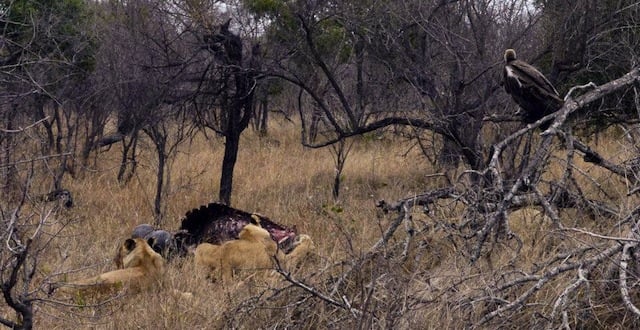
From the safety of a safari jeep I look on as a pack of lions — one male, two females and a cub — gnaw mercilessly at a now almost bare buffalo carcass, chewing at the bones and flipping the body over to find new meat. While it may same somewhat cruel, this is life in wild South Africa.
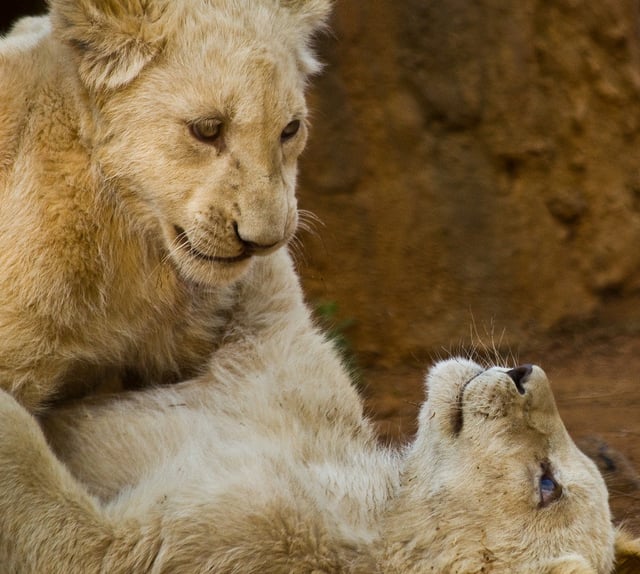
Wilderness Immersion
Before going on a safari, I expected to see the Big Five and take some photos of the wildlife; however, what I found was a more immersive experience where I didn’t just view elephants, lions, giraffe, hyena, zebra, leopards, hippos, rhinos and other exotic South African animals, but explored their natural habitats to see how they acted in their everyday life: A male lion trying to attract the attention of a female, an elephant drinking from a stream and eating leaves with its trunk, a wounded leopard trying to recuperate, a rhino leaving his mark with feces in order to find a suitable mate, a female lion protecting her cub, a giraffe keeping guard for a pack of zebra, an old wildebeest kicked out from its herd trying to befriend a group of impala. It’s witnessing these simple but natural moments that really makes you feel like you’re more than just an onlooker, but part of the animal kingdom.
That being said, I’m still new to this world of untouched wilderness where lions and leopards roam free without bars. They appear so strange to me, and I can’t help but wonder what the first people on Earth who saw these creatures must have thought. The enormous elephant, with its wrinkly body, banana leaf ears and floppy trunk that acts as part arm-part drinking straw. The wild dog, with its mangy fur, demonic stare and patches of wild patterns. The giraffe, with its bold printed fur, disproportionally tiny head and neck so long it appears more like a spotted tree than an animal. And the lion, with its golden mane like fire flaring from its face, intimidatingly muscular body, sharp facial features and claws that could rip almost any living being to shreds.

Kudu. Photo courtesy of HBarrison.
Animal Facts
Driving with my guides, Fanuel at the wheel and Devance tracking from the hood of the jeep, I learn a lot about the habits of the animals and flora of the landscape. Despite the odd features of the above mentioned wildlife, the most impressive for me is the kudu. With it’s elegantly twisted horns and speckled and striped face it’s hard for me to believe this mythical-looking creature is real. These animals are harmless to humans — which is good, because they hung out by my tent in the mornings — and tend to run when threatened rather than fight. Part of the antelope family, they feed on leaves, shoots and fruits and are hunted by big cats, python, wild dogs and hyenas. While males mainly travel solo or in bachelor groups, you can find them with females during mating season.
Another interesting animal is the leopard. The largest cat species to regularly climb trees, these spotted felines can drag kill up to three times their body weight into trees reaching over 20 feet (6 meters). They don’t just hunt from trees, however, but also water, as their diet contains a mix of seafood, rodents, rabbits, wathogs, primates and antelopes. Actually, leopards have an amazing ability to live in a variety of environments, to savannah to desert to woodland to mountaintop.

Buffalo and warthog interacting in the bush. Photo courtesy of kristin wolff.
Another interesting animal is the buffalo. Surprisingly, this is the most dangerous animal you’ll encounter in the wild, as it’s the only one who will charge you without stopping. While animals like lions and elephants often use charging as a scare tactic and will stop a few feet in front of you (as long as you don’t run), the buffalo will continue sprinting. And with its enormous size, a human is not likely to make it out alive. Fun fact: Buffalo are the only wild species of cattle.
And let’s not forget the lion. Interestingly, lions are each others’ biggest predator, as it’s not uncommon for lions to kill other lions, including cubs and females. While this may sound vicious, one of the most adorable sights you’ll encounter in the wild are a male and female lion greeting each other with a gentle rub. While they evoke fear in the mind of humans due to their strong hunting skills, they actually spend about 20 hours a day sleeping and do most of their hunting at night and in the very early morning.
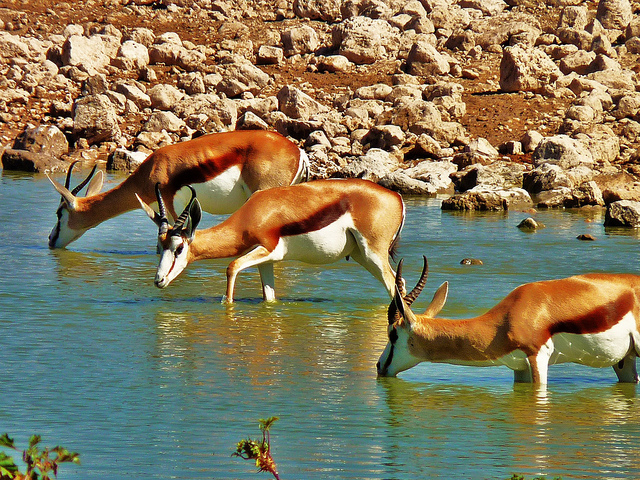
Springbok sipping from a stream. Photo courtesy of David W. Siu.
A Walk In The Bush
Despite witnessing firsthand how a lion can rip apart a 1,600 pound (725 kilogram) buffalo with its teeth, when Vaughan, a guide, invites the group on a bush walk my curiosity has me accepting the invitation.
“If you see an animal charging us, even if it’s a lion or an elephant, don’t run,” insists Vaughan, telling us the rules of the hike. “I know your instincts will tell you to get away from danger, but it’s the worst thing you can do. Stand your ground and there’s a good chance the animal will wonder why you’re not afraid of it and turn around. If you run there’s really no way it can end well.”
While it’s a warning that’s important to heed, the truth is humans are the top predator in the bush. We kill and eat almost every animal in the wild, from massive buffalo to sharp-toothed lion to the more defenseless springbok. When animals smell a human approaching they’ll typically keep their distance or hide; however, it’s those times when a human does something to make it feel threatened that it will attack out of self defense.
We walk close together in a single file, making sure to keep Vaughan and his rifle (which is only used for self defense) in front of us. Vaughan points out a muddy pond close to the camp.
“Recently I saw two rhinos fighting right here,” he recalls. “It was like two massive cars just crashing into each other over and over, and they make the most high pitched scream that sounds like a terrified woman.”
Vaughan also talks about his experiences coming into contact with lions while walking in the bush, something I had always believed you couldn’t do without being mauled to death; however, I soon learn that as long as you show respect to the animal and keep a safe distance they usually won’t attack (Note: Don’t attempt this without a trained guide!). In fact, according to Vaughan there are three male lions that hangout on the reserve that he’s “good buddies with,” although the female lions don’t like him much out of spite.
As we continue our walk we see some non-predatory animals, mainly a variety of antelope species, and an array of beautiful birds like wood hoopoe, lilac-breasted roller and the endangered ground hornbill. Interestingly, what becomes the focus of much of the tour is poop. While it may not sound like an appealing topic, Vaughan is full of interesting information relating to animal feces, and learning about it gives much insight into the animal world.
“Do you see how this pile has bones in it?” he asks, pointing to some dung. “This is hyena poop. Hyenas and jackals are the only animals in the bush to not just eat an animal’s meat, but also its bones.”
We also learn how rhinos use their feces to attract the opposite sex. In order to get the attention of a female, the male counterparts will leave a pile of droppings, from which the female can decipher how healthy he is and if you would make a good mate. From there she can choose to follow the trail or leave some droppings of her own as a reply.
Continuing the walk we pass vibrant purple wisteria, leadwood trees and tall golden grass. It’s in here where we have to be careful, as these grasses make the perfect hiding place for jaguars and lions who camouflage well into the long stalks. Suddenly, we happen upon the meatless carcass of a small indecipherable animal, as well as the horned skull of a once beautiful impala. Seeing these hunted animals is a strong reminder that I’m still in the bush.

Rhinos
Conservation Issues
Going on a South African safari isn’t all photographing animals and analyzing poop, as we also get into numerous discussions about important conservation issues, namely rhino poaching, trophy hunting, population control and zoos that offer experiences like lion holding.
South Africa’s main problem right now in terms of nature and conservation is rhino poaching, which refers to people sneaking into reserves and killing rhinos for their horns, which are thought to have medicinal properties like the ability to cure cancer and enhance a person’s sex drive. What’s sad is these horns are made of keratin, the same substance your finger nails and hair are composed of — meaning there are no medicinal properties, and if there were you could simply cut your nail for the same effect. That being said, typically the people killing these animals are very poor people from Mozambique, who with the poaching of one rhino could have their entire life changed, making it a very sensitive issue.
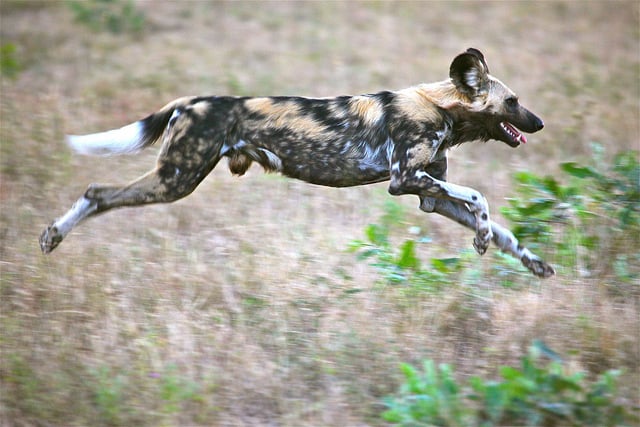
Wild Dog. Photo courtesy of jurvetson.
Another big issue is with population control of the animals, which also deals with trophy hunting. Elephants are one animal in particular that are overpopulated in many of South Africa’s reserves, which can be detrimental to the environment as they destroy the landscape as they eat leaves 24 hours a day and knock down trees. Some ways certain camps are dealing with the issue is to put the elephants on birth control or allow trophy hunters to come onto their land and hunt these big game in exchange for large sums of money. This not only helps to limit the population of the animals but also stimulates the local economy. Additionally, carefully regulated trophy hunting helps to also preserve current elephant populations because it provides a monetary incentive for locals to resist poaching elephants for their ivory tusks. That being said, it can be hard for many people to stomach the idea of people killing animals for sport, which makes the issue quite controversial.
While the guides have opinions on the issues affecting South Africa’s conservation, they tend to stand back and let nature run its course naturally. Although they have created a few man-made water points to help elephants get enough drinking water, for the most part they keep human interaction with the animals to a minimum to keep the wildlife wild. Sometimes there are exceptions, for example, if an animal has been harmed in an unnatural way, like when they find an antelope with a wire wrapped around its body or an elephant with a tire stuck to its leg. Thinking of all the instances around the world where human interaction with bush animals has reduced their natural hunting instincts, I think this is a great approach to keeping the reserve in its natural state.

A delicious museli cake gowned in mint yogurt and fresh fruit.
A Delicious Ending
After an evening game drive our group sits at a candlelit table under the stars, drinking local wine and enjoying delicious three-course meals. Tonight’s menu includes a chicken salad crostini canape, an appetizer of creamy mushroom risotto, an entree choice of pork fillet stuffed with apple and leeks and topped with a Savanah sauce or grilled pork chops covered in lamb sauce, and a dessert of bread and taro pudding gowned in chocolate sauce. The group sits, drinking wine and laughing about the day’s adventures. This is when the beauty of the experience all comes together, as we recount what we saw and how it affected us. Because on a South African safari you’re more than just a bystander, you’re part of the animal kingdom.
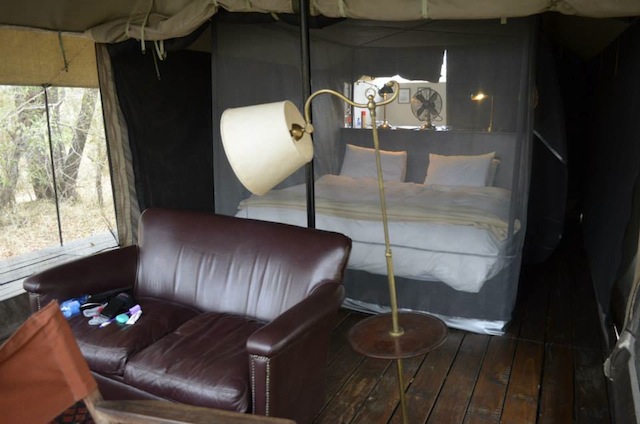
My room at Honeyguides Tented Safari Camps.
Logistics
Fly into Kruger Mpumalanga International Airport (Southern Kruger Park), Hoedspruit Eastgate Airport (Central Kruger Park) or Phalaborwa Airport (Northern Kruger Park).
Once you arrive, there is an itinerary that happens each day. Typically, you’ll wake up at 5:30am each morning (hot tea or coffee will be brought to your tent), for a game drive from 6am to 9am, including a stop for hot drinks and muffins. Once you arrive back at the camp you’ll enjoy a multi-course breakfast followed by free time with an option to take a guided bush walk. Around 2pm you’ll have a multi-course lunch followed by another three-hour game drive, including a stop for soft drinks, alcoholic beverages and snacks. Once you arrive back to the camp, you’ll sample canapes around the fire with hot drinks before filling up with a decadent three-course candlelit dinner.
When packing, keep in mind mornings and evenings can be chilly and weather can be unpredictable. Bring layers so that you’ll be ready for any season, as well as gloves, hats and a flashlight for at night. There is also free Wi-Fi if you have a device you want to connect with (although if you’re interested in disconnecting this is the perfect place to do it). Spend free time swimming in their onsite pool, drinking at the bar, taking an al fresco shower, enjoying the scenery from your porch or napping in the extremely comfortable beds provided. While not quite glamping, many of the safari camping offers a more comfortable experience than a typical breakdown tent, with a spacious living area featuring a big bed, leather couch, desk, small closet and wooden chest (to hide your belongings from the monkeys that sometimes sneak into the tent). There’s also an indoor/outdoor bathroom with toilet, shower, stone tub and sink with shower amenities.
In terms of tipping, it is customary to tip your guide about R120 per day (about $12 USD) and your tracker about R80 per day (about $8). That being said, feel free to tip more or less as you see fit.
Lions playing. Photo courtesy of Michael Rammell. Elephant photo: Mother and baby elephant having a drink. Photo courtesy of David W. Siu.

Jessica Festa is the editor of the travel sites Jessie on a Journey (http://jessieonajourney.com) and Epicure & Culture (http://epicureandculture.com). Along with blogging at We Blog The World, her byline has appeared in publications like Huffington Post, Gadling, Fodor’s, Travel + Escape, Matador, Viator, The Culture-Ist and many others. After getting her BA/MA in Communication from the State University of New York at Albany, she realized she wasn’t really to stop backpacking and made travel her full time job. Some of her most memorable experiences include studying abroad in Sydney, teaching English in Thailand, doing orphanage work in Ghana, hiking her way through South America and traveling solo through Europe. She has a passion for backpacking, adventure, hiking, wine and getting off the beaten path.








